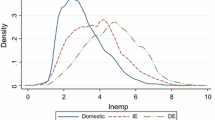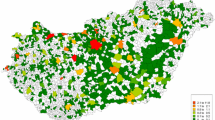Abstract
Does having more firms around exporting to a particular destination improve the chances of exporting to that destination (e.g. through information spillovers)? We answer this question implementing a multinomial logit model of whether a firm exports to a particular country. To identify the source of information spillovers, we construct indicators of geographical concentration of exporters selling to a specific destination: within industry, multinationals and across industries. In our application with data for Spanish new small sized firms, only within-industry agglomeration of exporting domestic firms significantly affects the probability of small sized firms exporting to the same destination. The significance of localisation economies is robust to a barrage of controls including destination specific characteristics, gravitational factors (distance and level of development), firm heterogeneity (size) and regional differences.
Similar content being viewed by others
References
Aitken B., Hanson G. and Harrison A. (1997). Spillovers, Foreign Investment and Export Behaviour. Journal of International Economics 43: 103–132
Alonso O., Chamorro J. M. and y González X. (2003). Spillovers geográficos y sectoriales de la industria. Revista de Economía Aplicada XI: 77–95
Bernard A. and Jensen J. (1999). Exceptional Exporter Performance: Cause effect or both?. Journal of International Economics 47: 1–25
Becchetti L. and Rossi S. (2000). The Positive Effect of Industrial District on the Export Performance of Italian Firms. Review of Industrial Organisation 16: 53–68
Bilkey W. and Tesar G. (1975). The Export Behaviour of Smaller-sized Wisconsin Manufacturing Firms. Journal of International Business Studies 8(Spring/Summer): 93–98
Bonacorsi A. (1992). On the Relationship Between Firm Size and Export Intensity. Journal of International Business Studies 23(4): 605–635
Castejón M. and Costa M. T. (1996). Economías externas y localización. Economía Industrial 305: 75–86
Castillo J. (1994). La Empresa Manufacturera Española en el ámbito del Comercio Intra-industrial: Incidencia del Capital Exterior sobre su Actuación. Economía Industrial 298: 151–159
Castillo J. and Requena F. (2003). Estrategias de Diversificación en las Exportaciones Manufactureras. Revista de Economía Aplicada 33(Winter): 101–120
Cavusgil S.T. (1984). Organisational Characteristics Associated with Export Activity. Journal of Management Studies 21(1): 3–22
Clerides S., Lauch S. and Tybout J. (1998). Is Learning-by-Exporting Important? Micro-Dynamic Evidence from Colombia, Morocco, and Mexico. Quarterly Journal of Economics 113: 903–947
Clerides, S. and G. Kassinis, 2001, ‘The Adoption of an Exporting Strategy as a Diffusion Process’, University of Cyprus, Working Paper
Dalli D. (1994). The Exporting Process: The Evolution of Small and Medium Sized Firms Towards Internationalisation. In: Axim, C. N. (eds) Advances in International Marketing, pp 85–110. JAI Press, Greenwich
Devereux M. and Griffith R. (1998). Taxes and the Location of Production: Evidence from a Panel of US Multinationals. Journal of Public Economics 68: 335–367
Eurostat, 1991, ‘Table of Correspondence: Combined Nomenclature’, NACE, SIC
Fujita M., Krugman P. and Venables A. (1999). The Spatial Economy: Cities, Regions, and International Trade. The MIT Press, Cambridge
Glaeser E. L., Kallal H. D., Scheinkman J. A. and Shleifer A. (1992). Growth in Cities. Journal of Political Economy 100(6): 1126–1152
Goicolea A. and Herce J. A. (1995). ‘Patrones Territoriales de Crecimiento Industrial en España, Documento de Trabajo‘. FEDEA, 95–14
Grubert H. and Mutti J. (1996). Do Taxes Influences where US Multinational Corporations Invest?. mimeo, US Treasure, Washington, DC
Hausman J. and McFadden D. (1984). Specification Tests for the Multinomial Logit Model. Econometrica 52: 1219–1240
Head K., Ries J. and Swenson D. (1995). Agglomeration Benefits and Location Choice: Evidence from Manufacturing Investment. Journal of International Economics 38: 223–248
Henderson V., Kuncoro A. and Turner A. (1995). Industrial Development in Cities. Journal of Political Economy 103(5): 1067–1090
Krugman P. (1991). Increasing Returns and Economic Geography. Journal of Political Economy 99(3): 483–499
Lautanen T. (2000). Modelling Small Firm’s Decision to Export – Evidence from Manufacturing Firms in Finland. Small Business Economics 14: 107–124
Leonidou, L. and C. Katsikeas, 1996, ‘The Export Development Process: An Integrative Review of Empirical Models’, Journal of International Business Studies, third quarter, 517–551
McFadden D. (1974). Conditional Logit Analysis of Qualitative Choice Behavior. In: Zarembka, P. (eds) Frontiers in Econometrics, pp 105–142. Academic Press, New York
Marshall A. (1920). Principles of Economics. Mcmillan, London
Malmberg T. (2000). The Impact of Agglomeration in Swedish Export Activity. Regional Studies 32: 134–145
McCallum J. (1995). National Borders Matter: Canada–U.S. Regional Trade Patterns. American Economic Review 85(3): 615–623
Minondo A. (2003). Internacional Trade and the Border Effect in the Vasc Country. Revista de Economía Aplicada XI: 113–131
Porter, P., 1992, ‘The Competitive Advantage of the Nations’, 1st edn. Ed. Addison-Maitler
Pyke F. and Sengenberger W. (1992). Industrial Districts and Local Economic Regeneration. Institute for Labour Studies, Geneva
Reid S. (1984). Information Acquisition and Export Entry. International Marketing Review 1(20): 44–56
Roberts M. and Tybout J. (1997). The Decision to Export: An Empirical Model of Entry with Sunk Costs. American Economic Review 87(4): 545–564
Ruud B. and Hausman J. (1987). Specifying and Testing Econometric Models of Rank-Ordered Data. Journal of Econometrics 34: 83–104
Sjöholm, F., 2000, ‘Do Foreign Contacts Enable Firms to Become Exporters?’ Stockholm School of Economics, Working Paper
Spence M. (2003). International Strategy Formation in Small Canadian High-Technology Companies – A Case Study Approach. Journal of International Entrepreneurship 1: 277–296
(2003). Stata Statistical Software: Release 8.0. Stata Corporation, College Station, TX
Tesar G. and Tarleton J. (1982). Comparison of Wisconsin and Virginia Small and Medium Sized Exporters: Aggressive and Passive Exporters. In: Czintoka, M. and Tesar, G. (eds) Export Management: An International Context, pp. Praeger Publishers, New York
Train K. (1986). Qualitative Choice Analysis: Theory, Econometrics and an Application to Automobile Demand. MIT Press, Cambridge, MA
Weidersheim-Paul F., Olson H. and Welch L. (1978). Pre-export Activity: The first Step in Internationalisation. Journal of International Business Studies 9(Spring/Summer): 47–58
Author information
Authors and Affiliations
Corresponding author
Rights and permissions
About this article
Cite this article
Silvente, F.R., Giménez, J.C. Information Spillovers and the Choice of Export Destination: A Multinomial Logit Analysis of Spanish Young SMEs. Small Bus Econ 28, 69–86 (2007). https://doi.org/10.1007/s11187-005-7324-3
Accepted:
Published:
Issue Date:
DOI: https://doi.org/10.1007/s11187-005-7324-3




